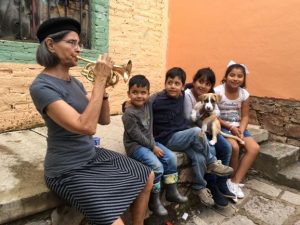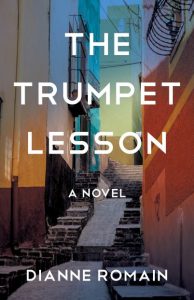Hands-On Research: How a Story of Hidden Loss Became The Trumpet Lesson
 It started with Pamela Fischer, a candid and confident young black woman who came to me one morning during a free write. From the moment Pamela appeared, I knew she would be the perfect foil to my protagonist, shy and quiet Callie Quinn, who hides the loss of the bi-racial baby she gave up for adoption decades before. Callie grew up in a small Missouri town and works as a translator in Guanajuato. Pamela is from Chicago. What would bring her to Guanajuato?
It started with Pamela Fischer, a candid and confident young black woman who came to me one morning during a free write. From the moment Pamela appeared, I knew she would be the perfect foil to my protagonist, shy and quiet Callie Quinn, who hides the loss of the bi-racial baby she gave up for adoption decades before. Callie grew up in a small Missouri town and works as a translator in Guanajuato. Pamela is from Chicago. What would bring her to Guanajuato?
One good friend in Guanajuato came from California to play first oboe with the University of Guanajuato Symphony Orchestra (OSUG). Other musicians from the U.S. play with OSUG, too. So why not Pamela? Next came the instrument—nice to have one I knew something about. Flute? I’d played one in junior high. Piano? At the time, I was studying with the OSUG keyboard artist. Pamela playing flute or piano would make my life easy. But Pamela refused. She would play the trumpet or nothing. She’s right, I thought. With a trumpet, Pamela could play classical music and jazz. She could even play with the mariachis. So, I made an appointment to interview Jason Pettit, who played trumpet with OSUG, and then I left with my guy to surf the gentle waves of Sayulita.
The Lure of Brass
At a stopover in Guadalajara, I decided to explore the neighborhood around our hotel. I had walked only a block when there appeared a window display before me glinting with brass. Trumpets! I leaned forward to read the tag hanging from one of them: 1,300 pesos—at the time, a little over 100 dollars. At that price, why not buy one? I could learn how it felt to blow into it. But could such an inexpensive instrument be worth anything? I took out my cell and called Jason. “It’s probably a Chinese knock-off,” he said. “It’ll do.” So I bought it.
I ended up falling in love with the trumpet. Over the next five years, I took lessons at every opportunity, usually in Guanajuato with Jason or visiting trumpeters, occasionally with a classical trumpeter in California or with a jazz trumpeter in Kansas City. One May, I observed masters-level classes and studied with a student at the Conservatoire National Supérieur de Musique et de Danse de Paris.
“The Lost Child”: How Callie Meets Pamela
In an early scene of The Trumpet Lesson, Callie is dining with her tympanist friend Armando at a plaza-side restaurant. Armando, who tends toward hysteria, has convinced himself that Pamela is hiding his dog, Tavelé. He tries to persuade Callie to take a trumpet lesson as a ruse to search for Tavelé. Callie refuses, of course. But then the mariachis begin playing “The Lost Child.” The trumpeter who’s off behind a tree playing the lost child’s part turns out to be Pamela. Fascinated by Pamela’s vulnerability and poise, Callie surprises herself and Armando by asking Pamela for a lesson.
Ways My Trumpet Lessons Informed The Trumpet Lesson
Many details from my lessons and experiences playing the trumpet found their way into the novel. After returning the trumpet she borrowed to the mariachi, Pamela puts her mouthpiece in a little leather pouch, a pouch like the one Jason gave me. Echoing Jason, Pamela calls Callie’s trumpet “a genuine Chinese knock-off.”
There’s more. Callie recalls her father playing “whisper tones,” notes played very, very quietly, and “pedal tones,” base notes below a trumpet’s normal range. She recalls the circular indent on her father’s lips when he finished practicing. She recalls that when her father played songs images came to her.
Callie learns to start a buzz by pretending to flick something off her tongue. She learns that her lips tingle after playing. She learns to practice for short periods and to pause during practice to rest her lips. She learns that, by modifying rhythm and dynamics, a trumpeter can make the same repeated notes sound sad or happy.
Life Lessons in Trumpet Lessons
“Okay,” you say, “there’s plenty about the trumpet in the novel. But why did you title your novel about a woman who’s silent about the loss of her child The Trumpet Lesson?”
Callie, we learn early on, has breathing issues. During their first lesson, Pamela tells Callie that a trumpeter she studied with in Paris said, “Sound is a gift of the breath.” I got this wording from my teacher at the Paris Conservatory. But all of my teachers emphasized the importance of breathing for playing the trumpet, and, of course, so does Pamela, who focuses the entire first lesson on teaching Callie to breathe.
Over and over again we find Callie reluctant to speak her mind during a conversation. When Callie is reluctant to make a sound on the trumpet, Pamela counsels her to practice listening to the notes she plays without judging them. “It’s all about practicing awareness,” Pamela says. My teachers offered similar advice. Musicians who listen without judging express their musical ideas more fully.
Advice for playing the trumpet has broader application. By breathing freely and listening carefully to ourselves, we end up better able to live our most deeply held values. As with much wise counsel, “breathe fully and listen” is easier said than done. You’ll discover—when reading The Trumpet Lesson—whether Callie ever learns her lesson.
—
Dianne Romain grew up in Missouri and studied philosophy at the University of Missouri at Kansas City. After completing her PhD in Philosophy at UC Berkeley, she taught feminist ethics and philosophy of emotion at Sonoma State University and published Thinking Things Through, a critical thinking textbook. While in California, she practiced fiction writing techniques in a women’s writing group. In Guanajuato, where she lives with novelist Sterling Bennett, she took up the trumpet as research for her debut novel, The Trumpet Lesson. Her current writing projects set in Guanajuato include short stories and a second novel. Visit her at https://dianneromain.com/.
THE TRUMPET LESSON
 Fascinated by a young woman’s performance of “The Lost Child” in Guanajuato’s central plaza, painfully shy expatriate Callie Quinn asks the woman for a trumpet lesson — and ends up confronting her longing to know her own lost child.
Fascinated by a young woman’s performance of “The Lost Child” in Guanajuato’s central plaza, painfully shy expatriate Callie Quinn asks the woman for a trumpet lesson — and ends up confronting her longing to know her own lost child.
When Callie became pregnant in 1960s rural Missouri over thirty years ago, her outraged father, with her mother’s acquiescence, insisted that no one know—and Callie complied. She went away, and she gave up her baby. She did it to protect the baby’s father—a black teen—from the era’s racist violence.
When Pamela, the trumpeter whose music flows from her heart, enters Callie’s life, Callie begins to dream of opening her own heart. But instead she remains silent, hiding her longing and risking giving up everyone she dares to love in order to safeguard her secret. Callie tells herself she does so to protect her daughter, but ultimately, in order to speak, she must confront the deepest reasons for her silence—the ones she’s been concealing even from herself.
BUY THE BOOK HERE
Category: On Writing






























